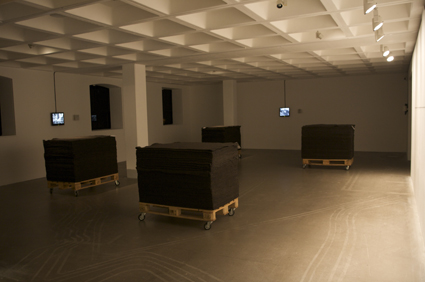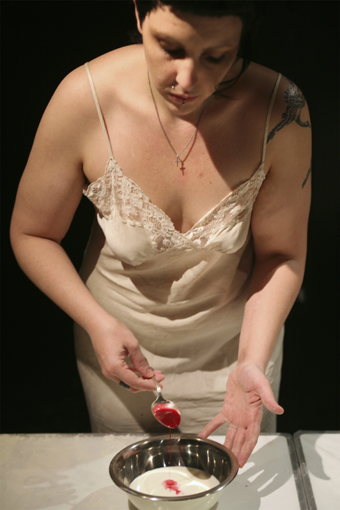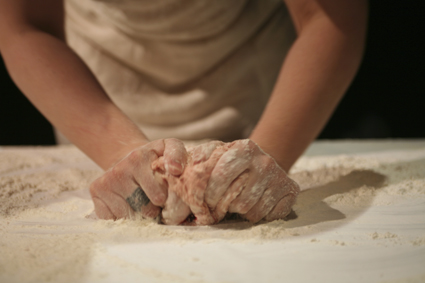 |
Zoran Todorovic, Warmth photo Carl Newland |
zoran todorovic: warmth
I walked into the room and made a beeline for the rectangular piles of felt that looked like folded blankets. Heaped on pallets they extended upwards to just the right height for me to finger them, and to get my nose down in there. They smelt clean. Matted fibres, mostly bear-colour. Some lighter strands, some white.
I’ve noticed elsewhere that European hair-colour averages out to brown, even in Scandanavia. So the blankets default to a brindled dark mass. Mounted on the gallery wall, monochrome videos on fast-forward sum up the process of making at length. The hair is cut at the barber's, mostly into a far-from-pretty no-frills back-and-sides. So seldom does the camera peer over the subjects’ shoulder to spy at a face in the mirror that when it happens, it comes as a shock. The backs of so many heads presenting! It’s like forming an impression of personality from the look of a person’s arse. Not that that can’t be done.
Blunt, defended scrubby heads. Utilitarian, no-nonsense settings. A couple of women are fleetingly glimpsed amongst those who do the barbering. For the rest it’s all men. In the video the shorn hair is gathered up, emptied on to tables and sorted by hand. Tissues and other detritus are picked out of it. The clumps of hair are teased and dried out in heaps on the floor and then shredded (a little) and carded in big industrial rollers, washed and felted in the steel machines. Blokes in heavy boots and overalls deployed in utilitarian structures of concrete and steel wield brooms and black bin liners under a fluorescent flicker. All the dander and the smell, the shed organic dirt that the hair must have collected is sifted out, washed off, got rid of. The blankets have been passed through an industrial process, they have been standardised and homogenised and, to a degree, purified, all obtrusively particular matter has been removed. Yet the gallery is somehow humming with essence of Bloke: hardy, gruff, obtuse, stoic.
There is no smell beyond the suggestion of a smidgeon of grease—I daresay human grease smells awful to other mammals but not to us. Just as well—I’m asthmatic, me, and have to be careful with fibres. These fibres are contained. Then I catch myself wondering what kind of garment one could make from this material, that one could bear to wear. A heavy skirt perhaps. I can picture being wrapped in this dense prickly insulating shield. For an hour or two perhaps it would not be insufferable. Perhaps.
I know that there is an ideology that determines the course of this work. I know there is a brooding, a nationalism and an exclusivity. But the de-naturing of this material, this organic remnant, renders it general. What remains is the implicit presence of hundreds and hundreds of men, their tangible residue rendered down and processed, ranked and arrayed, stacked on its pallet, ordered by the machine. The installation simulates a stack of commodities ready for some Spartan, barrack-like environment: a trading post, a quartermaster's store.
The artist further makes use of the context of the gallery to hammer home his point about commodification: the blankets are for sale in the Arnolfini shop. Paradoxically the narrative and ideology of the work is pervaded by a seductive tenderness, the ‘warmth’ of the blankets, and by a sense of brotherhood, of community. The iconographic referencing of the major European trauma of the 20th Century, the Holocaust, I needed to have pointed out to me before I saw it, and it still jars.
 |
Sarah Jane Norman, Take This, For It Is My Body photo Carl Newland |
sarah jane norman: take this, for it is my body
“THIS WORK DEALS WITH THE GENERATIONS OF ‘HALF-BLOOD’ ABORIGINAL CHILDREN, INCLUDING THE ARTIST’S OWN MOTHER, WHO WERE AFFECTED BY THE GOVERNMENT’S REGIME OF ‘ASSIMILATION’.” INBETWEEN TIME FESTIVAL PROGRAM.
There’s a woman in an old satin slip welcoming me into the Dark Studio. It’s the sort of thing you wear when you’re slopping about the house getting on with something that’s needed to be done for a while. A garment that used to be glamorous and is now comfortable—that you feel self-indulgent in however shabby it gets. She has bare feet. There is a wonderful smell of bread baking.
Before I came in here I had to sign a disclaimer: “Please be advised that the ingredients include the blood of the artist. Please understand that you are not obliged to eat or accept this offering. If you choose to do so this will be entirely at your own risk.”
It’s like a dare, isn’t it?
She greets me. We are on either side of a long table. There’s a small industrial oven behind us in the corner. There’s another table parallel to this one, a couple of floury baking trays on it, three or so loaves proving under a cloth. To the side against the wall is a table set for one with fine linen, plain crockery, a pat of butter and a butter knife and a napkin-covered basket. There’s an area on the floor with towels, a jug and a bucket of water, and there are black bags of supplies against another wall. It’s like a cottage production line, some kind of back-country industry the farmer’s wife fits in with her other duties. Stylistically there’s something about the combination of the efficient and the genteel that reminds me of the 50s.
 |
Sarah Jane Norman, Take This, For It Is My Body photo Carl Newland |
Sarah Jane Norman pours the blood into the buttermilk and stirs. That turns it a dense pink, like Angel Delight. She pours this into the flour and mixes. The pink persists as the mixture starts clumping, darker material from the clot streaking through the dough. Amazing that such a small amount of blood has such a strong effect. She turns out the dough, kneading it, shaping it, slashing a cross into the top. She takes it to the next table to sit and prove with the other loaves (which show that definite tinge of pink as if they were special party bread). She goes to wash her hands in the bucket over by the towels.
The oven pings—the loaf that was put there before I entered the room is ready. Norman places it to cool by the proving loaves.
She invites me to sit at the place laid for one. Lifting the napkin from the basket she uncovers a rough, warm loaf, no longer pink. She cuts me a good slice, making eye contact all the time. It’s crusty, slightly bitter—that could be the baking soda—a bit heavy. I help myself to butter. If I’d tried to eat a whole slice we’d have been there for ages.
Succinct, earthy, confrontational, full of confidence, giving. Personal, not industrial, locating the political in the heart of family and domestic life, where it can do the most damage. About survival, not victimhood. Two very contrasting approaches to discourse about ethnicity and the threat of genocide.
Inbetween Time Festival of Live Art and Intrigue, Zoran Todorovic, Warmth, Arnolfini, Dec 1-Feb 6; Sarah Jane Norman, Take This, For It Is My Body, Arnolifini Dark Studio, Dec 4; Dec 1-5, Bristol UK
Our coverage of the 2010 Inbetween Time Festival is a joint venture between RealTime and Inbetween Time Productions
Osunwunmi is an artist living in Bristol. After a long time working in video she is cautiously but optimistically moving into Live Art practice
RealTime issue #101 Feb-March 2011 pg. 24, web
© Osunwunmi ; for permission to reproduce apply to [email protected]








 back
back